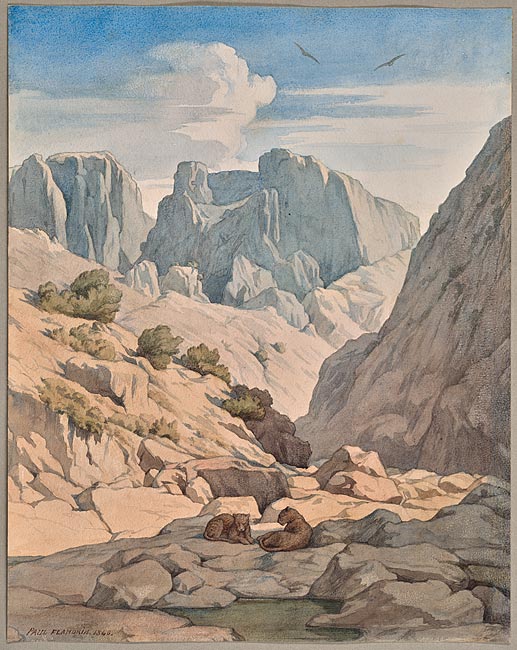

Together with his older brother Hippolyte, Paul Jean worked in the atelier of Ingres, who regarded him as one of his favorite pupils. Endowed with a singular talent for watercolors, he produced many landscapes and urban views. This imaginary landscape is partially inspired by a real location, the famous Gorges d'Ollioules, near Marseille, a wild valley enclosed by arid heights that can be seen in the distance.
In 1843, on a summer trip to the Rhône valley with stops in Bagnols, Viviers, and Toulon, Flandrin painted the Gorges d'Ollioules using a muted and earthy palette in 1843, a canvas now in the Louvre (RF 1997-8). He also made a pencil study of the site with two boys in the foreground among the rocks (private collection). The rock formation, now a massive gray and white outcropping, appears as the Jordanian desert in an 1844 painting of the Baptism of Christ for the chapel of the baptismal font in the Church of Saint-Séverin. In 1845, he used these works as the basis for a large canvas titled “Les Gorges d'Atlas,” where a man is startled by a snake on a rock in the shady foreground, and the background opens up to a brilliantly light gray-white rock formation that dominates the scene, with a bright blue sky streaked with a cloud illuminated by the sun (Musée d'art et d'histoire, Langres).
This watercolor, dated 1846, borrows the background motif from the Saint-Severin canvas and the Langres painting but converts it to a vertical format as in the pencil sketch, from which the foreground is adapted. Surprisingly, he adds a crouching tiger and another reclining tiger or lioness in the shade near a pool of water in a nod to the idea of the “orient,” which artists were finding closer to home in the terrain of the south of France.
Signed and dated in brown ink at lower left, "Paul Flandrin 1846."
Robinson, Hamiliton, Jr. former owner.
Robinson, Hamiliton, Mrs. former owner.
